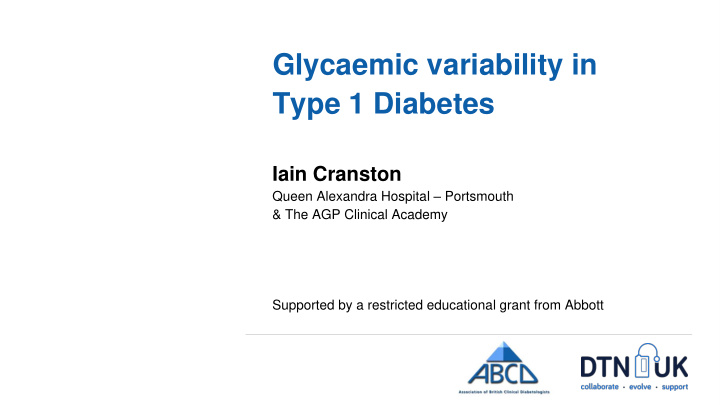



Glycaemic variability in Type 1 Diabetes Iain Cranston Queen Alexandra Hospital – Portsmouth & The AGP Clinical Academy Supported by a restricted educational grant from Abbott
Dr Iain Cranston • Consultant Diabetologist: Queen Alexandra Hospital, Portsmouth • Company Directorships: The AGP Clinical Academy (UK / US) www.agpclinical.org Southern Diabetes Medical Services Disclosures: Personal fees and educational grants from: Abbott Diabetes Care, Ascensia, NovoNordisk, Eli Lilly, Sanofi, MSD, Boehringer Ingelheim, Napp Pharma, Roche (Accu Chek), BioEpic
Learning objectives • Understand the impact of glucose variability and its common causes • How to identify variability • How to reduce variability
Why is glucose variability important? • Traditional measures of glucose control (eg HbA1c) tend to rely on the overall average glucose level • To achieve a reduction in this average (and so reduce "exposure" to excessive glucose levels) is often seen as the goal of therapy • However, undue focus on the average can lead to problems with hypoglycaemia if the differences in glucose levels between one day and another (variability) are not addressed
A1c 7.1 or 6.8 – which would you prefer? A1c 6.0 or 6.2 – which would you prefer?
Glucose control is more than just HbA1c Glucose Exposure A1c / MPG FLUX Variability Instability Between Day In-day change Change Hypoglycaemia
Variability results from different daily instability patterns but… Over 2 weeks this can be overwhelming to view on a single image, so an alternate presentation is required
How does FreeStyle Libre show multiple days? “The AGP” (daily patterns view) The AGP is made up of 5 lines; The 10 th / 25 th / 50 th / 75 th / 90 th centiles The darker shaded area (inter-quartile range) represents half of all the readings (ie. those ‘usually’ experienced) The lighter shaded area (inter-decile range) represents 4/5 of all the readings (ie. those ‘sometimes’ experienced) The highest and lowest 10% of all readings are left off the image as they represent extreme experience which is unusual
How does variability differ from exposure? The width of the area shaded dark blue represents usual variability The width of the area shaded light blue represents occasional variability The area under the median line represents the same as the average The estimated A1c is calculated from this
What does variability look like on the AGP? Non-diabetic Good Control Speaker’s Data
So, if between-day variability results from different patterns of instability each day… What could be causing that instability on these days, and why is it different between the 2 days?
Over treatment Over Over correction correction Asymptomatic nocturnal hypoglycaemia Over Over treatment correction Carbs no insulin
Some other causes of fluctuation… • Insulin Mismatch • Meal composition • Co-morbid Illness • Carbohydrate counting errors • Other medications • Excessive correctional insulin • Injection technique / • Hypoglycaemia needles • Fear of Hypoglycaemia • Injection sites / • Insulin omission / duplication lipohypertrophy • Injection timing • Alcohol / recreational drugs • Physical exercise • Menstrual Cycle / Pregnancy • Stress … and many more!
How can I assess (& address) this?
Making a plan to address variability • To see variability you have to look at a series of days (after the event) • The logical time to do this is at the end of one sensor whilst waiting for the next to warm up (ie in the hour “start up” period) • Look on a PC or tablet (use Libre or LibreView software) • Do not worry about the numbers, instead… • Look at the daily patterns graph (AGP) as a picture and ask yourself: • How does this picture compare with an “ideal” ? • Which bits of the day show the greatest difference from that ideal? • What decisions do I make at that time of day? • What could I try to do differently in the next 2 weeks to change that? • Don’t be scared to discuss with your HCP if you’re out of ideas
What’s ideal? An AGP Representing ‘Good Diabetes Control’ As much of the blue shape as possible should fit inside the ”target range” Box between 4 and 10mmol/L This means there can’t be either too much variability or instability
So, how does this picture need to change?
1 First…reduce variability (narrow it)
1 First…reduce variability (narrow it) 2 Then…improve stability (flatten it)
1 First…reduce variability (narrow it) 2 Then…improve stability (flatten it) 3 Then reduce exposure (lower it) which will often happen on its own after 1 and 2
An example: Andrew • 44 yr old man • Type 1 diabetes since aged 11 • HbA1c for last 5 years in 7.5 – 8.5% range (most recently 8.3%) • Treatment with basal/bolus MDI (Lantus/Humalog; DAFNE graduate) • 28 units Lantus / I:C 1:10 & ISF 1:3 (TDD 50-55units)
1 st 2 weeks sensor wear Variability starts to increase late morning as he Tries to correct the rise after breakfast Starts the day Variability settles with low variability again overnight but rising BG So, if his BG levels did not rise with breakfast then he wouldn’t need to correct and his variability might remain low ACTION therefore increase insulin:carb ratio at breakfast
1 month after intervention This is now a near ideal profile - his afternoon and evening variability have greatly reduced and this has allowed him to achieve a lower HbA1c without risk of hypos It has stayed like this ever since (last 2 years)!
Summary • Glucose variability is important because it gets in the way of achieving overall glucose-related goals • Variability increases the hypo risk • Reducing variability is often the first step to improving overall control • To see variability use the Daily Patterns Profile (AGP) • Make a habit to look at the end of each sensor • Decide on one change to make if the picture does not match your ideal and review in another 2 weeks • Discuss with your HCP if not making progress!
Recommend
More recommend